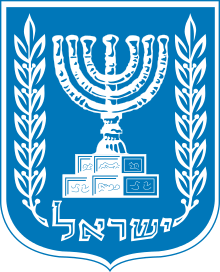Assembly of Representatives election, 1920
 |
| This article is part of a series on the politics and government of Israel |
|
Legislature |
Elections to the Assembly of Representatives were held in Mandate Palestine on 19 April 1920, except in Jerusalem, where they were held on 3 May.
Background
Following the British conquest of Ottoman Palestine in 1917, Jewish leaders met in Petah Tikva on 17 November to discuss the formation of a representative convention.[1] After Jerusalem fell to the British, another convention was held, this time in Jaffa, to discuss the establishment of an organisation for the Jews of Palestine.[2] A committee was formed with the mandate to hold elections to a Constituent Assembly.[2]
With northern Palestine still held by the Ottomans, a second convention was held in Jaffa in July 1918 and elections were scheduled to be held by the end of 1918.[2] However, after the armistice was signed in November, delegates were required to represent Palestinian Jews at the peace conference.[2] A third convention was held in Jaffa on 18 December, to which every settlement, community and political party were invited.[2] Chaim Weizmann and Nahum Sokolow were chosen to represent the community at the peace conference.[2]
The elections were then postponed several times,[3] before they were fixed for 26 October 1919.[4] However, they were postponed again as Weizmann was worried that internal divisions would weaken the Jewish negotiating position.[4] The date was finally set for 19 April 1920 after it was confirmed that the British would have the Mandate for Palestine.[4]
Electoral system
At the first meeting in Jaffa, it was decided that the election would be held using secret balloting, and would be direct.[2] However, no agreement was made on women's suffrage.[2] The second meeting confirmed that men and women over the age of 21 would be entitled to vote, although the issue of women candidates remained unresolved.[2] The issue was raised at the third Jaffa convention, and despite opposition from Orthodox Jews, it was decided that women would be allowed to stand as candidates.[2] However, ultimately the Orthodox held separate elections in Jerusalem on 3 May, from which women were banned from participating.[4]
Voters elected one member for every 80 voters, except for the Orthodox, who elected one for every 40 voters on the basis that women were banned from their vote.[4] A total of 263 delegates were elected in the general voting, and another 51 by Orthodox voters.[4]
Results
| Party | Seats |
|---|---|
| Ahdut HaAvoda | 70 |
| Histadrut HaSephardim | 54 |
| Haredi Party | 53 |
| Hapoel Hatzair | 41 |
| Histadrut Haikarim | 16 |
| Advanced Party | 13 |
| Yemenite Association | 12 |
| Mizrachi | 9 |
| Unnamed Group | 7 |
| Independents | 7 |
| Craftsmen's Centre | 6 |
| Women's Union | 5 |
| Bukharan Jews | 5 |
| Clerk's Union | 5 |
| Youth of Israel Union | 4 |
| Citizen's Union | 3 |
| Mizrahi Youth Union | 2 |
| Georgian Jews | 1 |
| Maccabi Union | 1 |
| Total | 314 |
Around 22,000 of the 26,000 registered voters participated in the election.[4]
Aftermath
The Assembly met for the first time on 7 October 1920, and voted to admit the 51 Orthodox representatives.[4] It also elected the Jewish National Council to serve as an executive committee.[4]